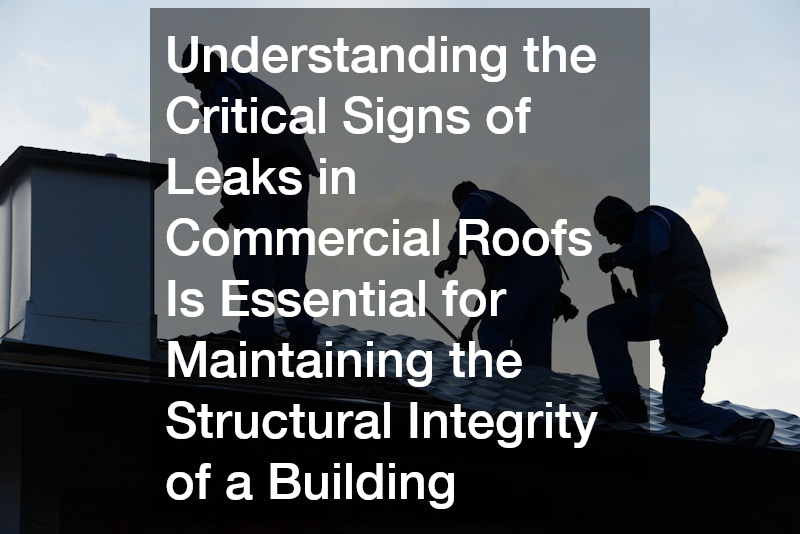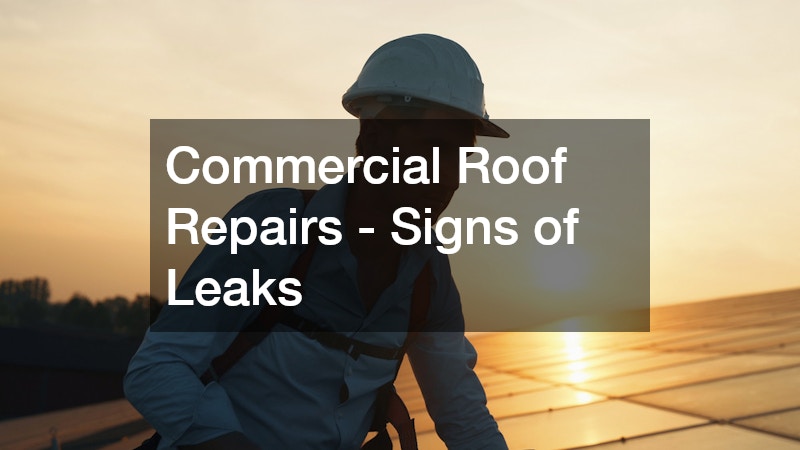Understanding the critical signs of leaks in commercial roofs is essential for maintaining the structural integrity of a building. Timely identification and commercial roof repairs are key to minimizing costly damages and maintaining a safe business environment.
How Can You Identify Leaks in a Commercial Roof?
Spotting Water Stains and Dripping
Water stains or drips from the ceiling are often the most obvious indicators of a leaking roof. These stains might appear as brown or yellowish circles on the tiles or paint, which can expand over time.
Noticing these signs early can prevent further water intrusion and structural issues.
Checking for dripping water is crucial, especially after heavy rain. Dripping might seem minor at first, but it indicates that water has penetrated the roofing materials and is slowly damaging the framework. Maintenance staff should regularly inspect remote or less visible areas of the roof regularly.
In some cases, water stains can appear far from the actual leak due to the slope and design of the roof. By understanding the paths water may take, facilities managers can more accurately pinpoint problem areas and address them before they worsen.
Recognizing Musty Odors
Musty odors often accompany leaks, indicating stagnant water and potential mold growth. These odors are generally noticeable in enclosed or poorly ventilated sections of a building, where moisture doesn’t dry up quickly. Identifying and eliminating the source of these odors is critical for maintaining a healthy environment.
The presence of a persistent musty smell should trigger an immediate investigation. It often means that water has been sitting undetected for some time, leading to material decay and possible mold formation. Regular inspections of roof spaces and interior walls can help catch these problems before they escalate.
Eliminating musty odors goes beyond simple air freshening. The root cause—most often moisture intrusion—must be addressed to ensure that the odor does not return and to prevent long-term damage and health issues associated with mold.
Identifying Damage in Rooftop Equipment
Rooftop equipment such as HVAC units and vents can also show signs of leaks. Rust, corrosion, or pooling water around such installations may indicate improper sealing or damage to flashing, both of which can lead to leaks.
Examining the seals and joints of rooftop equipment is an essential part of regular maintenance checks. Any gap or deterioration can serve as a pathway for water infiltration, which could not only affect roofing materials but also impair the functionality of the equipment itself.
Facilities should ensure that all equipment is properly installed and regularly maintained to prevent leaks. Technicians should look for signs of wear and tear such as peeling paint, rust, or loose connections and address these issues promptly.
What Causes Leaks in Commercial Roofs?
Poor Installation Practices
Poor installation practices often set the stage for future leaks. This could include improperly laid materials, inadequate sealing of seams, or incorrect slopes that prevent effective drainage. Even if a roof seems sound initially, these factors can lead to gradual water infiltration.
When roofs are installed without following industry standards or using subpar materials, their durability is compromised. A seemingly small error in installation can have significant repercussions years down the line, hence the necessity for hiring qualified professionals.
Regular inspections following installation can catch errors early before they become severe. By ensuring high-quality craftsmanship and products from the start, building owners can save significant amounts in repair and replacement costs.
Weather-Related Damage
Extreme weather conditions are a leading cause of roof leaks. Heavy rains, high winds, hail, or snow can damage the roofing material, causing weaknesses or openings that allow water to penetrate.
Storms may also result in debris falling onto the roof, which can puncture membranes or tiles. Consistent exposure to these elements without proper defenses can deteriorate even the best roofing over time.
Employing weather-resistant materials and ensuring regular post-storm inspections can mitigate these risks. Understanding regional weather patterns can aid in choosing appropriate roofing solutions that are resilient to local climate challenges.
Neglected Maintenance
Neglecting roof maintenance is another primary source of leaks. Over time, minor wear and tear can evolve into significant issues. Regular cleaning, inspections, and prompt repairs are necessary to keep the roof in optimal condition.
Without regular attention, small problems like clogged gutters or loose shingles can lead to bigger and costlier issues, including structural integrity risks or the need for full roof replacement. Maintenance should be proactive rather than reactive to prevent leaks.
Building owners should establish a maintenance schedule, engaging with roofing professionals for periodic evaluations. This not only extends the life span of a roof but also ensures the safety and comfort of a building’s occupants.
What Are the Consequences of Ignoring Roof Leaks?
Structural Damage
Ongoing leaks can significantly weaken structural components of a building. Continuous water exposure can rot wooden supports, rust metal fastenings, and weaken concrete, jeopardizing the entire building’s stability.
Ignoring leaks for an extended period can lead to sagging ceilings, warped floors, and weakened walls. Moreover, extensive structural damage can necessitate comprehensive and expensive rehabilitation projects.
Proactively addressing leaks can avoid these drastic outcomes. By repairing leaks promptly and ensuring dry, protected building materials, the structural integrity of a building can be maintained.
Health Hazards from Mold
Persistent leaks create ideal conditions for mold and mildew, which can pose serious health risks to occupants. Mold spores can exacerbate allergies, trigger asthma attacks, and cause respiratory irritations.
The health implications of mold growth are urgent and demand timely intervention. Regular cleaning and dehumidifying, coupled with repairing leaks, can curb mold growth and prevent health problems.
It is crucial for businesses to maintain a healthy environment for employees and clients. Addressing leaks and their causes promptly promotes a safer and more productive atmosphere.
Increased Repair Costs
Delaying repairs often results in higher costs over time. What starts as a minor leak can soon escalate to more serious damage, requiring extensive and expensive repairs.
Immediate attention to leaks minimizes the financial burden of major repairs, which may include replacing large sections of a roof, interior restorations, and even structural corrections.
In the long run, investing in regular maintenance and immediate repairs saves money. Financial resources are better allocated to proactive care rather than costly reactive solutions.
Regular inspections and prompt repairs are vital for preventing leaks and ensuring the longevity of a commercial roof. Addressing early signs of leaks not only safeguards the building but also protects the health and safety of its occupants. By focusing on quality installation, regular maintenance, and timely interventions, businesses can avoid the many pitfalls associated with commercial roof leaks.


